|
The Roman Catholic Church either side
of the Channel
Both Kent and the North of France were converted
to Christianity in the 7th-8th centuries. St. Augustine in
Kent, St. Omer and St. Vaast in northern France established
many religious communities. In the Middle Ages, both regions
invested huge resources in building huge, elaborate gothic
cathedrals and abbeys - stone masterpieces that took
centuries to build, and towered over the low timber hovels
that ordinary people lived in.
Back to
top
|
|
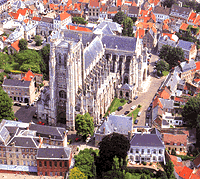 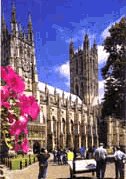 Back
to top
Back
to top
Saint-Omer and Canterbury Cathedrals -
both gothic masterpieces representing an enormous investment
of creativity and resources by quite poor communities over
several centuries
|
|
The Reformation
& the start of Protestantism
In the 16th century came a sharp divide. In 1517 a
German monk, Martin Luther, started an explosion of protest
against corruption, abuses of power and teachings of the
Roman Catholic church. His followers, "Protestants", called
for people to rely on the Bible rather than on bishops and
the Pope; and to worship in a simpler way.
Protestant Criticisms
In Europe, bishops and the clergy often lived like
aristocrats, and seemed part of the ruling elite. Corruption
was rife: for example, bishops not undertaking religious
duties, or even not living in their diocese. In France, the
king rather than the Pope chose people for church positions.
In Louis XIV’s court, bishops vied with nobles to make
extravagant displays of wealth - often by endowing religious
works of art. Luther criticised the Church for selling
"indulgences" - i.e., saying God would pardon people’s
sins if they gave to the Church. The Protestants objected to
bible readings and services being in Latin - "mumbo-jumbo"
that few ordinary people understood.
Catholic churches were full of works of art: statues,
shrines, paintings, relics of saints, altars ornamented with
gold and jewels. Lofty cathedrals were designed for the
performance of fine music, from choirs and later with
organs. All these practises Protestants described as
“pagan idolatry”.
|
|
The English
Reformation 1530
England joined the Protestants because Henry VIII
quarrelled with the Pope, who refused to give Henry the
divorce he wanted for political reasons. In 1534 Henry
established the Church of England as the official state
church, nominally Protestant, with the monarch as head -
“defender of the faith”.
Remarkably quickly, English people turned against the
Pope and the Roman Catholic Church. - church buildings and
the style worship were made much plainer. Like other
Protestants, the Church of England introduced everyday
language into services - English instead of Latin. They
printed a new Prayer Book, and the first newly-translated
official English Bible. They whitewashed over colourful wall
paintings, removed many statues and stained glass windows,
and destroyed all the shrines and saints' relics which had
attracted pilgrims to many cathedrals, abbeys and
monasteries. They ended the practice of people paying the
Church to be forgiven their sins.
The Church of England never defined very precisely
exactly what its members were supposed to believe in. But
the Bishops were now appointed by the English monarch, not
the Pope in Rome. Back
to top
|
|
Counter-Reformation
In 1534 in Spain, Ignatius Loyola founded the
“Society of Jesus”, the Jesuits, to revive
the Catholic church. Responding to the success of the new
Protestant churches, the Pope called a catholic conference,
the Council of Trent in 1545 to discuss
reforms, which, led by the Jesuits, began to take effect
from 1560. The abuses by the most corrupt of the clergy were
tackled. The Jesuits set up colleges to train clergy all
over the catholic world, including at Saint-Omer
and Douai. Their zeal led
to excesses, echoing the Spanish Inquisition, founded in
1478 to hunt out Jews suspected of practising their
forbidden faith in secret.
English attitudes to
Catholics
English observers were horrified at news from France
of civil war between Protestants and Catholics (1562-98).
The massacres of
Protestants in France (1572), the Spanish
Armada (1588), and the Gunpowder Plot
(1605) confirmed the popular belief in England that
Catholics and the Pope would bring tyranny. They saw that
attacks on England by Catholic France or Spain had the
blessing of the Pope. Very soon any English person who
wanted to remain a Catholic was seen as a potential traitor
and spy.
For centuries after, English
Catholics were persecuted and denied civil rights.
17th century Catholic revival
The most visible reminder of this era that we can see
today is the great flowering of religious art in churches.
The Council of Trent gave guidelines to artists, to produce
works of art that conveyed simple religious messages to the
faithful - about Bible stories and the lives of the
saints.
Retables
Many churches in Flanders have elaborate baroque
altar-pieces dating from the 16th - 18th centuries,
commissioned under Spanish or French rule. See 'Retables".
Mays
Starting in 1630, the goldsmiths of Paris each year
on 1st May gave a giant specially-commissioned painting on a
religious theme to hang in the nave of Notre-Dame Cathedral
in Paris. Arras museum has a 'Salle
des Mays' where you can see some that have survived.
|
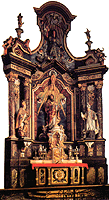
The counter-reformation led to a
burgeoning of religious art to help communicate the
Church’s message
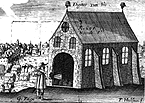
The 1605 Gunpowder Plot involved
English Catholics
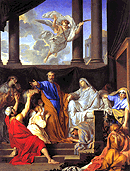
Painters' illustrated stories about
the Apostles, following detailed rules.
|
|
1789 French
Revolution
In France, the Catholic Church had remained a great
power in the land. The poor saw the Bishops and the Church
as their oppressors, just as bad as the King and the
aristocracy. In the North the clergy owned as much land as
the aristocracy - each had about 1/5th of the total.
In the turmoil of the 1789 French
Revolution, as well as beheading the King and sending
many nobles to the guillotine, many cathedrals, abbeys and
monasteries were also destroyed. The new Republic was
atheist. By 1802, it had confiscated all the Church's land
and property; the nobles lost almost half theirs. Church
lands were sold cheaply to peasant farmers and to
businessmen - creating a big class of people who had a
personal interest in keeping what they had gained by the
Revolution.
Napoleon's “Concordat” with
the Pope
Napoleon made a
"concordat" with the Catholic church, agreeing which church
buildings would be returned to enable the bishops and
priests to carry on. The Catholic church was again made the
official state religion; the state resumed paying money to
the church and appointing bishops - but people remained free
to practice any other beliefs. Back
to top
|
|
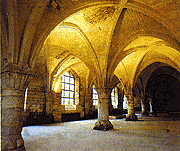
Ruins of Vaucelles Abbey near
Cambrai
|
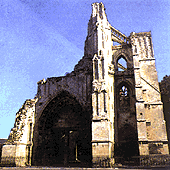
Ruins of Saint Bertin's Abbey in
Saint-Omer - another victim of the Revolution
|

An 18th century abbey became the museum & art gallery in
Arras. Napoleon allowed the adjacent Abbey chapel to become
a cathedral for Arras, to replace that destroyed in the
Revolution.
|
|
1814 Return of the
French Monarchy
The Church and the aristocracy had to accept that
they would not get much of their property back - this would
have been deeply unpopular. The church had got used to
operating on a smaller scale than before the Revolution, but
some monastic institutions were now reopened.
Return to Catholicism
The Catholic Church remained very powerful throughout
the 19th century. New monasteries and convents were built,
like the Mont des Cats near Bailleul, and a new Cathedral
for Lille, the growing industrial centre and provincial
capital. Most people returned to Catholicism; the church ran
the hospitals, and organised what help was available to the
poor and needy. From 1833 the Church allied with the Second
Republic to expand primary education. Many village schools
were opened, and most school teachers were priests, monks or
nuns.
Boulogne cathedral - burnt
down in the Revolution - was slowly and expensively rebuilt,
in a very different style to the old gothic cathedrals. It
is in the baroque style, similar to St. Paul's in London -
with the world's biggest dome outside St. Peters in
Rome. Back
to top
|

The re-building of Boulogne cathedral - after its
destruction in the Revolution - was finally completed in the
1860s. It huge dome was meant to dominate the
town.
|
|
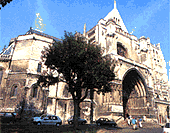
St. Omer Cathedral was one of the few
major gothic churches to survive the Revolution
|
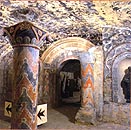
Below Boulogne cathedral, the large
old crypt contains remains of an older 3rd cent. Roman
temple, a 14th cent. shrine, and 15th cent. painted
walls.
|











